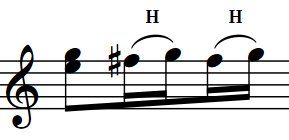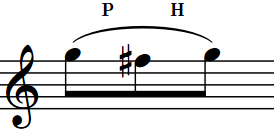Hammer-ons and pull-offs
Hammer-ons and pull-offs involve performers tapping or plucking the strings of fretted instruments with their left hand strongly enough that the corresponding pitch sounds without additional striking, producing a legato effect. Ligados are a combination of at least one hammer-on and one pull-off in a single phrase.
Hammer-ons and pull-offs are notated as the letters H or P respectively combined with a slur spanning the corresponding notes. Dorico SE automatically centers hammer-on/pull-off indications on slurs. For ligados, each hammer-on/pull-off indication is centered over the range of notes in the corresponding direction.

By default, hammer-ons/pull-offs appear on both notation staves and tablature and are placed above the staff. You can change the staff-relative placement of individual hammer-on/pull-off indications.
In Dorico SE, hammer-on/pull-off indications are considered properties of notes.
- Hammer-ons
-
Hammer-ons specify that the performer should tap the string at the specified pitch with their left hand without restriking the string. Hammer-ons require at least two notes on the same string with an ascending pitch direction, such as C-D. In Dorico SE, hammer-ons appear as a letter H.

Figure 2. Hammer-ons on notation staff - Pull-offs
-
Pull-offs specify that the performer should pluck the string at the specified pitch with their left hand without restriking the string. Pull-offs require at least two notes on the same string with a descending pitch direction, such as D-C. In Dorico SE, pull-offs appear as a letter P.

Figure 3. Pull-off on notation staff - Ligados
-
Ligados specify that the performer should both hammer on and pull off notes within a single phrase. Ligados require at least three notes on the same string with alternating pitch directions, such as C-D-C. In Dorico SE, ligados comprise at least one hammer-on and pull-off.

Figure 4. Ligado on notation staff